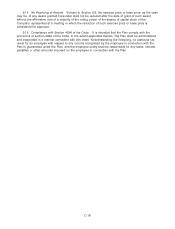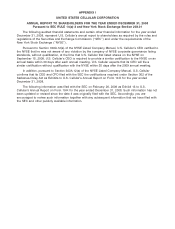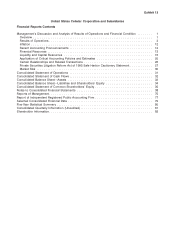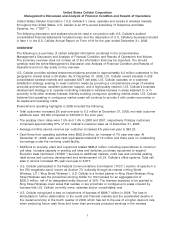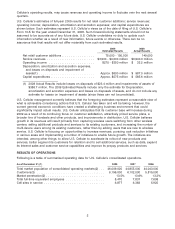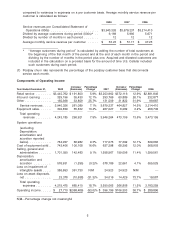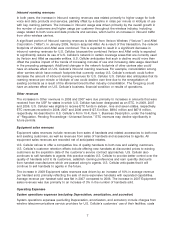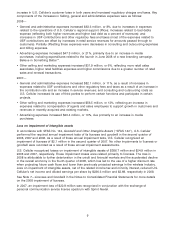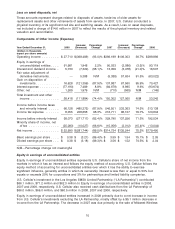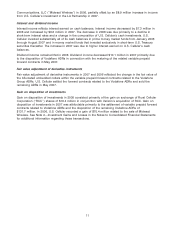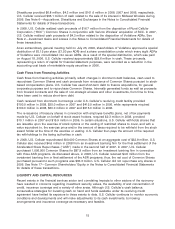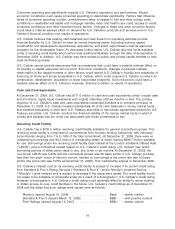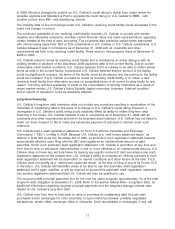US Cellular 2008 Annual Report Download - page 129
Download and view the complete annual report
Please find page 129 of the 2008 US Cellular annual report below. You can navigate through the pages in the report by either clicking on the pages listed below, or by using the keyword search tool below to find specific information within the annual report.Inbound roaming revenues
In both years, the increase in Inbound roaming revenues was related primarily to higher usage for both
voice and data products and services, partially offset by a decline in rates per minute or kilobyte of use
with key roaming partners. The increase in inbound usage was driven primarily by the overall growth in
the number of customers and higher usage per customer throughout the wireless industry, including
usage related to both voice and data products and services, which led to an increase in inbound traffic
from other wireless carriers.
A significant portion of Inbound roaming revenues is derived from Verizon Wireless (‘‘Verizon’’) and Alltel
Corporation (‘‘Alltel’’). In January 2009, Verizon acquired Alltel. As a result of this transaction, the network
footprints of Verizon and Alltel were combined. This is expected to result in a significant decrease in
inbound roaming revenues for U.S. Cellular, because the combined Verizon and Alltel entity is expected
to significantly reduce its use of U.S. Cellular’s network in certain coverage areas that are currently used
by Verizon and Alltel as separate entities. U.S. Cellular anticipates that such a decline would more than
offset the positive impact of the trends of increasing minutes of use and increasing data usage described
in the preceding paragraph. Additional changes in the network footprints of other carriers also could
have an adverse effect on U.S. Cellular’s inbound roaming revenues. For example, consolidation among
other carriers which have network footprints that currently overlap U.S. Cellular’s network could further
decrease the amount of inbound roaming revenues for U.S. Cellular. U.S. Cellular also anticipates that its
roaming revenue per minute or kilobyte of use could decline over time due to the renegotiation of
existing contracts as a result of the aforementioned further industry consolidation. The foregoing could
have an adverse effect on U.S. Cellular’s business, financial condition or results of operations.
Other revenues
The increases in Other revenues in 2008 and 2007 were due primarily to increases in amounts that were
received from the USF for states in which U.S. Cellular has been designated as an ETC. In 2008, 2007
and 2006, U.S. Cellular was eligible to receive ETC funds in sixteen, nine and seven states, respectively.
ETC revenues recorded in 2008, 2007 and 2006 were $127.5 million, $98.0 million and $67.9 million,
respectively. As described in U.S. Cellular’s Form 10-K, Item 1. Business Description, under the heading
of ‘‘Regulation, Pending Proceedings—Universal Service,’’ ETC revenues may decline significantly in
future periods.
Equipment sales revenues
Equipment sales revenues include revenues from sales of handsets and related accessories to both new
and existing customers, as well as revenues from sales of handsets and accessories to agents. All
equipment sales revenues are recorded net of anticipated rebates.
U.S. Cellular strives to offer a competitive line of quality handsets to both new and existing customers.
U.S. Cellular’s customer retention efforts include offering new handsets at discounted prices to existing
customers as the expiration date of the customer’s service contract approaches. U.S. Cellular also
continues to sell handsets to agents; this practice enables U.S. Cellular to provide better control over the
quality of handsets sold to its customers, establish roaming preferences and earn quantity discounts
from handset manufacturers which are passed along to agents. U.S. Cellular anticipates that it will
continue to sell handsets to agents in the future.
The increase in 2008 Equipment sales revenues was driven by an increase of 10% in average revenue
per handset sold, primarily reflecting the sale of more expensive handsets with expanded capabilities.
Average revenue per handset sold was flat in 2007 compared to 2006. The increase in 2007 Equipment
sales revenues was due primarily to an increase of 3% in the number of handsets sold.
Operating Expenses
System operations expenses (excluding Depreciation, amortization, and accretion)
System operations expenses (excluding Depreciation, amortization, and accretion) include charges from
wireline telecommunications service providers for U.S. Cellular’s customers’ use of their facilities, costs
7



